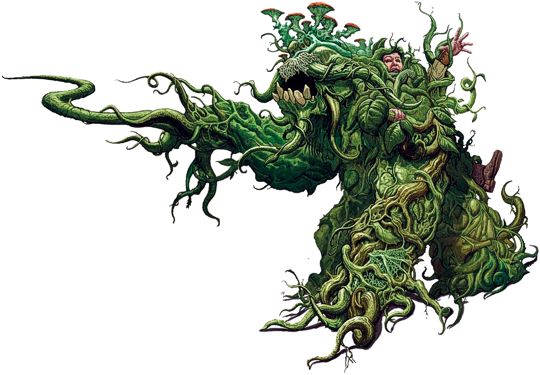

MC Volume Two • Monstrous Manual

| Climate/Terrain: | Wet subterranean or swamps and marshes |
|---|---|
| Frequency: | Rare |
| Organization: | Solitary |
| Activity Cycle: | Any |
| Diet: | Omnivore |
| Intelligence: | Low (5-7) |
| Treasure: | B,T,X |
| Alignment: | Neutral |
| No. Appearing: | 1-3 |
| Armor Class: | 0 |
| Movement: | 6 |
| Hit Dice: | 8-11 |
| THAC0: | 8 HD: 13 9-10 HD: 11 11 HD: 9 |
| No. of Attacks: | 2 |
| Damage/Attack: | 2-16/2-16 |
| Special Attacks: | Suffocation |
| Special Defenses: | See below |
| Magic Resistance: | Nil |
| Size: | L (6-9’ tall) |
| Morale: | Fanatic (17-18) |
| XP Value: | 8 HD: 6,000 (+1000 for each added Hit Die) |
Shambling mounds, or “shamblers”, appear as heaps of rotting vegetation. They are actually an intelligent form of vegetable life, roughly humanoid shaped, with a height of six to nine feet and a girth of about six feet at their base (legs to waist) and two feet at their summit (the “head”).
Combat: Shambling mounds are fearless attackers and are perhaps the most deadly form of plant life known. Their huge armlike appendages inflict 2-16 points of crushing damage each time they hit, and an unlucky victim hit by both arms in the same round is entangled in the slimy vines and rotting vegetable matter of the creature. Entangled creatures suffocate in slime in 2d4 rounds unless the shambler is killed or the victim breaks free (on a successful bend bars/lift gates roll).
The shambler’s powerful attacks are supported by a combination of defenses that make shambling mounds invulnerable to most normal attacks. The vast amounts of thick vegetation covering the important inner body protect the shambling mound very well, thus its AC of 0. All edged and pointed weapons that strike the shambling mound successfully cause only one-half damage since the blows are greatly weakened as they pass through layer upon layer of cellulose fibers and slime. Since shamblers can collapse themselves at will, crushing weapons inflict no damage at all upon them.
Fire-based attacks are ineffective against the wet and slimy shambling mounds, and cold-based attacks cause only one-half (if saving throw is failed) or no damage (if saving throw succeeds) to the creature, due to their essentially vegetable nature. Lightning actually causes a shambling mound to grow in size if used against it (add one foot in height, 1 Hit Die, and appropriate hit points for each lightning-based attack it is subjected to).
Spells that normally affect plants are effective against shambling mounds. Spells such as plant control and charm plant have proven the most successful so far.
Shambling mounds often lie in shallow bogs waiting for hapless creatures to walk on top of them. The usually surprised beings (-3 penalty to their surprise rolls) are struck and smothered often before they can even call for help.
Shambling mounds are almost totally silent and invisible in their natural surroundings (-3 penalty to opponents’ surprise rolls). They are not above creeping slowly into the camps of unsuspecting travelers at night. They are excellent swimmers as well.
Habitat/Society: Shambling mounds are only found in regions of dense rainfall and vegetation. Dismal swamps, marshes, and rain forests are their favorite climes, but some wet subterranean places also serve as shambled lairs. They are solitary beasts, only rarely living in the same area as other shamblers – usually only in areas where the food source is constant (e.g., near famous ruins or abandoned gold mines, etc.).
Ecology: The shambling mound is an animate clump of vegetation with a small brain-like control center located deep within the “chest” cavity. Decapitating a shambling mound, therefore, does not harm it in the least. Since a shambling mound’s “limbs” are merely aggregated clumps of vine and moss, the removal of one or more of them does not hamper the creature either. Remaining vines along the torso will join together to form a new limb by the next round. Only when enough of the shambling mound has been hacked away will the creature die.
Note that a wounded shambling mound need only retreat to a dense clump of wet foliage to heal. It will rise again in 12 hours, fully healed. It is likely to be very angry as well.
Since shamblers gain power from electrical attacks, it is suspected that there may exist some shamblers that are vastly larger than the common ones seen thus far. Since will-o-wisps and shamblers often inhabit the same desolate regions of the world, it is possible that shambling mounds of 20 Hit Dice or more lie in the deepest, darkest swamps and jungles.
